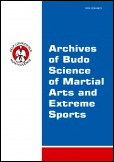2014, Volume 10, Issue 1
Rotating training simulator – an apparatus used for determining the moment of inertia, assisting learning various motor activities during rotational movements and simulating falls imposed by internal force
Andrzej Mroczkowski1
1Faculty of Physical Education, University of Zielona Góra, Zielona Góra, Poland
Full text
Abstract
One of the three factors identifying forms of extreme physical activity (including extreme sports) is ‘coordination difficulty’. The aim of the present paper is to recommend the rotating training simulator as an apparatus that can exercise three functions: determining the moment of inertia, improving motor habits while performing certain ”rotation techniques” in various sports disciplines, simulating the effect of the external force as the cause of losing balance and falling by a man who originally was immobile (standing, sitting, kneeling, etc).The apparatus consists of a rotating platform, which for measuring the moment of inertia is driven by the action of a falling mass. In a training mode the device can also be driven by an electric motor. The measurement of the speed of the rotating platform with a subject placed on it is done by an encoder connected to a logic controller PLC. The controller through a serial interface connector is connected to a PC computer which records the results of measurements and saves them in the archives. Recording of the subjects’ positions assumed on the training simulator is performed by using a video camera. This makes it possible to compare the obtained picture record with the record of the angular velocity obtained at the same time and thus to analyse the correlation between the reached angular velocity with the assumed body position.An example of determining the moment of inertia of a person for the body position in break dance using the training simulator, as well as visualisation (graphical and filming) of the training simulator applications in a training mode provides, in the author's opinion, sufficient arguments for proving the apparatus usability for scientific research and training. The apparatus can successfully attend to improving our knowledge of phenomena related to rotational movements of a human being and of his adapting abilities to motor activities with frequent occurrence of such events. The increased probability of a person finding himself in such a situation contrary to the subject's (individual's or a team's) will is especially common for soldiers, policemen, rescuers etc. and that is why the training simulator can be used as an apparatus assisting training of members of such formations.
Key words: sports techniques, moment of force, motor safety, biomechanics





